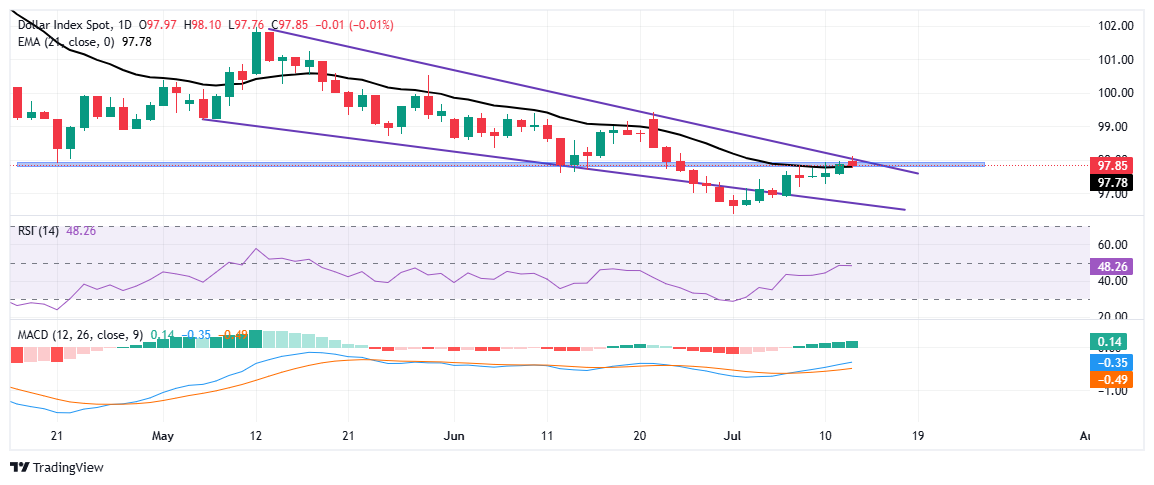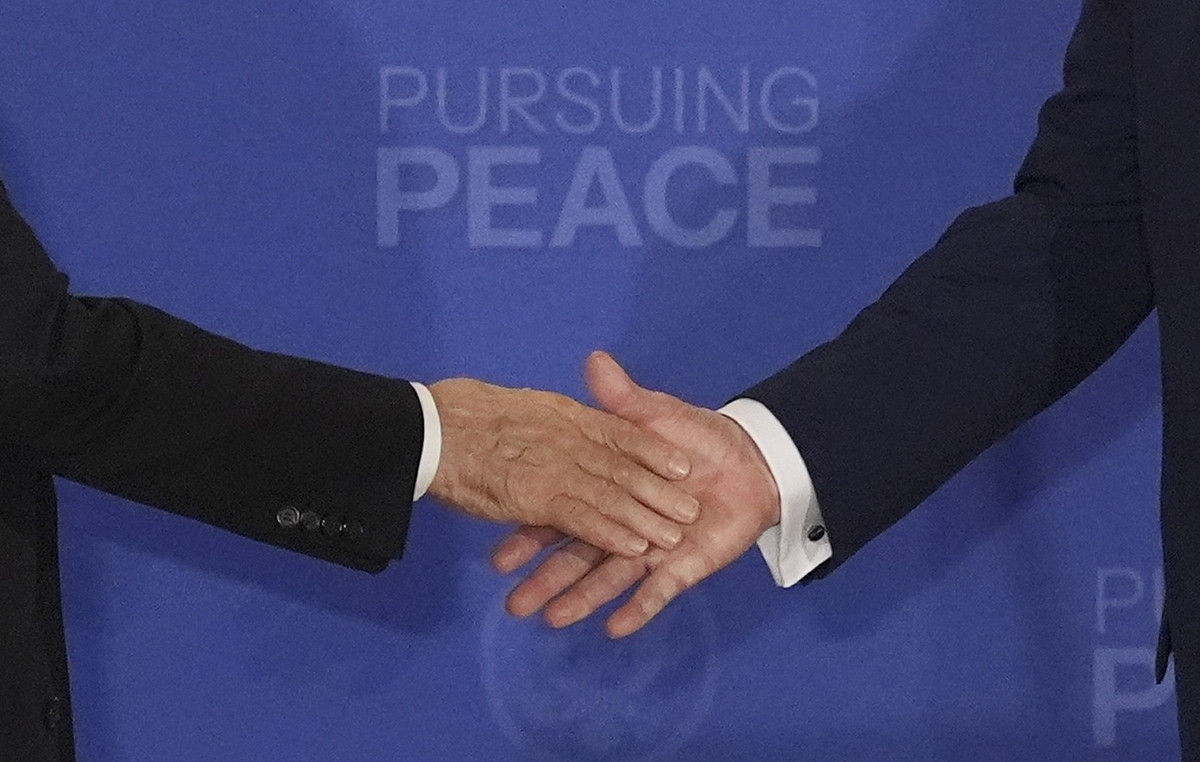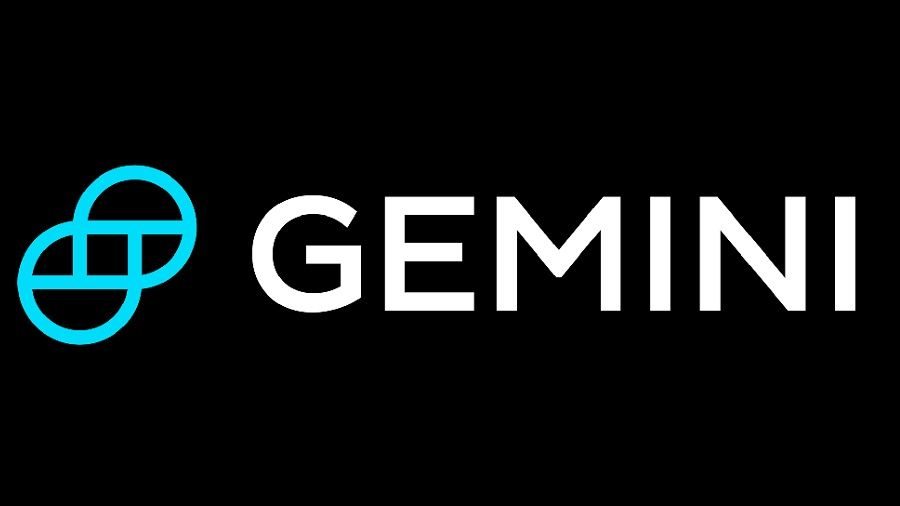- The US dollar opens the week with a firm tone but softens slightly in the day.
- The US president Trump threatens the European Union and Mexico with 30%tariffs, expanding his pressure campaign on international trade.
- The DXY dollar index It remains about a maximum of two weeks but struggles to overcome the key resistance in 97.80-98.00.
The US dollar (USD) began with a positive bias, maintaining the profits of last week while the operators responded to renewed commercial tensions. However, the dollar is quoted slightly on the day, since investors adopt a cautious tone, since, during the weekend, the US president Donald Trump re -captured attention when adding to the European Union (EU) and Mexico to his growing list of tariff objectives.
The US dollar index (DXY), which measures the value of the dollar against a basket of six main currencies, remains close to two -week maximum. At the time of writing, the index is consolidating just below the 98.00 mark, quoting around 97.80 during the European negotiation session.
Although the uprising impulse last week is largely intact, the DXY is struggling to break a confluence of key levels of resistance. Investors are now focusing their attention on the June Consumer Price Index (CPI), scheduled for publication on Tuesday, which could provide a new address for the US dollar and remodel expectations around the next monetary policy steps of the Federal Reserve (FED).
During the weekend, President Trump, in his usual style, revived commercial tensions by issuing warning letters to the EU and Mexico, announcing plans to impose new tariffs from August 1.
In the letter to the president of the European Commission, Ursula von der Leyen, Trump declared that the US would implement a 30% tariff on all EU assets unless the block offers “full and open access to the United States market.” He criticized the EU for “large commercial deficits, persistent and long term,” qualifying the relationship “far from being reciprocal.” He warned that if the EU responds, “any number you choose to increase will be added to 30% we charge.”
In a separate letter to the president of Mexico, Claudia Sheinbaum, Trump linked the tariff threat to fentanyl traffic, accusing Mexico of not doing enough to stop cartels. “Mexico has not yet arrested cartels trying to convert all of North America into a narcotics traffic park,” he wrote. A similar 30% tariff on Mexican imports will also enter into force next month, unless Mexico takes more forceful measures.
Although both letters adopted a combative tone, Trump left the door open for future adjustments, saying that tariffs “could be modified, upward or loss, depending on our relationship with his country.”
Market movements: tariff tensions intensify, Powell in political sights
- The latest tariff warnings aimed at the EU already arrived shortly after the US sent similar letters to more than 20 countries during the past week. Nations such as Canada, Japan, South Korea, Brazil and Thailand were informed that they could face new import taxes that range between 25% and 50%, unless new bilateral trade agreements are ensured before August 1. Although immediate reactions have been measured, the scope of threats is feeding underlying concerns about interruptions in the supply chain and retaliation measures that could affect global markets.
- The EU responded after the US tariff threat, qualifying the proposed tariffs of 30% excessive and harmful to transatlantic trade. The president of the European Commission, Ursula von der Leyen, expressed her disappointment, but emphasized the “commitment of the block to dialogue, stability and a constructive transatlantic association.” In a statement on Sunday, he confirmed that the EU would delay its planned retaliation tariffs, originally scheduled to enter into force this week, hoping to reach a negotiated solution before the deadline of August 1. However, he warned that the proposed tariffs “would interrupt the essential transatlantic supply chains” and stressed that the EU would take proportional countermeasures if the conversations fail.
- As commercial tensions intensify, the EU is intensifying its efforts to forge a united front with other important economies. The EU Commission of Commerce, Maroš šefčovič, said on Monday that the European Commission is actively working to involve G7 partners, such as Canada and Japan, to coordinate their response to the US tariff threats. “We have always been talking to our main commercial partners, especially those of G7. What is happening is that there is a new sense of urgency, “he told reporters before a meeting with the EU trade ministers, According to Politico.eu.
- Mexico firmly responded to the last tariff threat, with President Claudia Sheinbaum qualifying the proposed tariffs of 30% of unfair and counterproductive. He defended the continuous efforts of Mexico to address the traffic of fentanil and organized crime, pointing out recent operational and an increase in safety cooperation with the US. While the response was critical, Mexico made it clear that it prefers a diplomatic path and has no intention of climbing tensions to counteract tariffs, at least for the moment. The officials also clarified that the proposed tariff would only apply to Mexican goods not covered by the treaty between Mexico, the United States and Canada (T-MEC).
- The tensions between the White House and the Fed intensified as officials increased their criticism to the president of the Fed, Jerome Powell, this time due to the growing costs of the renewal project of the headquarters of the Central Bank. The total cost, according to reports, jumped from 1.9 billion dollars to almost 2.5 billion dollars, which caused a strong response from the White House advisors. The main economic advisor, Kevin Hasett, confirmed that the administration is examining whether the president has the legal authority to dismiss Powell, citing concerns about poor tax management. The growing political pressure on Fed is generating concerns about the independence of the Central Bank, which could weigh on the US dollar.
Technical Analysis: The DXY points to a break over the key resistance

The US dollar index (DXY) is quoting just below the 98.00 mark after registering a modest recovery from a minimum of several years.
On June 1, the index fell to 96.38, its lowest level in more than three years, after a false break below a descending wedge pattern. However, the movement failed to trigger additional sales, and the DXY has been gradually going up since then.
The index is now floating just above the 21-day exponential (EMA) mobile average and testing a key resistance confluence around 97.80-98.00-an anterior support area that has now become resistance, aligning with the upper limit of the descending wedge.
Momentum indicators are showing early recovery signs, although conviction remains moderate. The relative force index (RSI) has risen to the neutral level of 50, reflecting an improved but undecided tone.
The indicator of convergence/divergence of mobile socks (MACD) in the daily chart shows a continuous improvement in the bullish momentum. The MACD (blue) line has crossed above the signal (orange) line, often seen as an early sign that an ascending momentum is being built. In addition, the histogram bars have become positive, confirming that the short -term trend has moved in favor of the bulls. That said, the MACD is still below the zero line, which indicates that the broader trend is still weak and that recent profits can still be part of a corrective rebound within a larger bearish trend.
A daily closure above the upper limit of the wedge and the psychological brand of 98.00 would point out a possible breakdown of the recent bearish trend and strengthen the upward case for greater rise. Such movement could pave the way for a rebound towards the 98.50-99.00 area.
On the other hand, 97.50 now serves as immediate support, and a break below this level could attract sales pressure, exposing the lower wedge limit and the minimum of several years about 96.38 as the next key objectives down.
US Dollar – Frequently Questions
The US dollar (USD) is the official currency of the United States of America, and the “de facto” currency of a significant number of other countries where it is in circulation along with local tickets. According to data from 2022, it is the most negotiated currency in the world, with more than 88% of all global currency change operations, which is equivalent to an average of 6.6 billion dollars in daily transactions. After World War II, the USD took over the pound sterling as a world reserve currency.
The most important individual factor that influences the value of the US dollar is monetary policy, which is determined by the Federal Reserve (FED). The Fed has two mandates: to achieve price stability (control inflation) and promote full employment. Its main tool to achieve these two objectives is to adjust interest rates. When prices rise too quickly and inflation exceeds the 2% objective set by the Fed, it rises the types, which favors the price of the dollar. When inflation falls below 2% or the unemployment rate is too high, the Fed can lower interest rates, which weighs on the dollar.
In extreme situations, the Federal Reserve can also print more dollars and promulgate quantitative flexibility (QE). The QE is the process by which the Fed substantially increases the flow of credit in a stuck financial system. It is an unconventional policy measure that is used when the credit has been exhausted because banks do not lend each other (for fear of the default of the counterparts). It is the last resort when it is unlikely that a simple decrease in interest rates will achieve the necessary result. It was the weapon chosen by the Fed to combat the contraction of the credit that occurred during the great financial crisis of 2008. It is that the Fed prints more dollars and uses them to buy bonds of the US government, mainly of financial institutions. Which usually leads to a weakening of the US dollar.
The quantitative hardening (QT) is the reverse process for which the Federal Reserve stops buying bonds from financial institutions and does not reinvote the capital of the wallet values that overcome in new purchases. It is usually positive for the US dollar.
Source: Fx Street
I am Joshua Winder, a senior-level journalist and editor at World Stock Market. I specialize in covering news related to the stock market and economic trends. With more than 8 years of experience in this field, I have become an expert in financial reporting.







